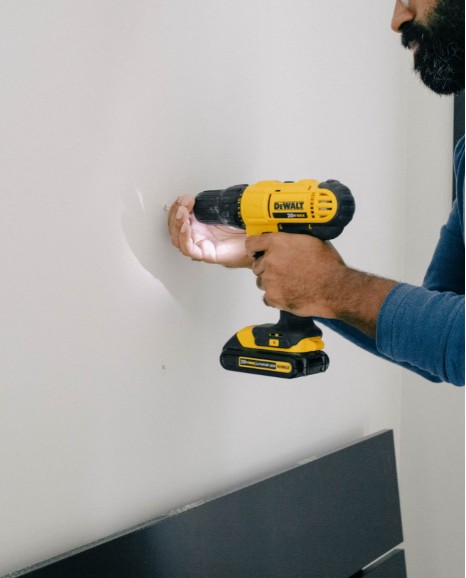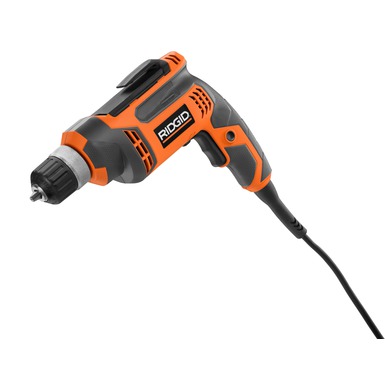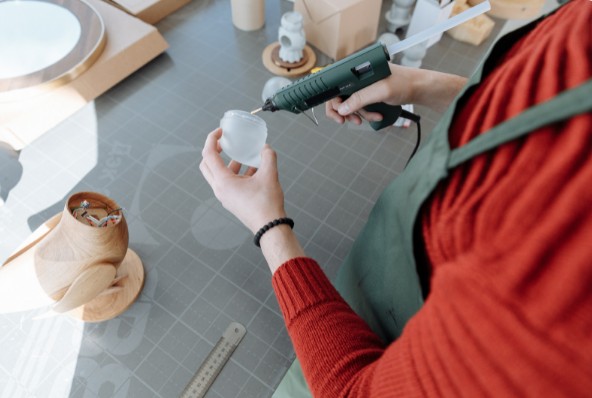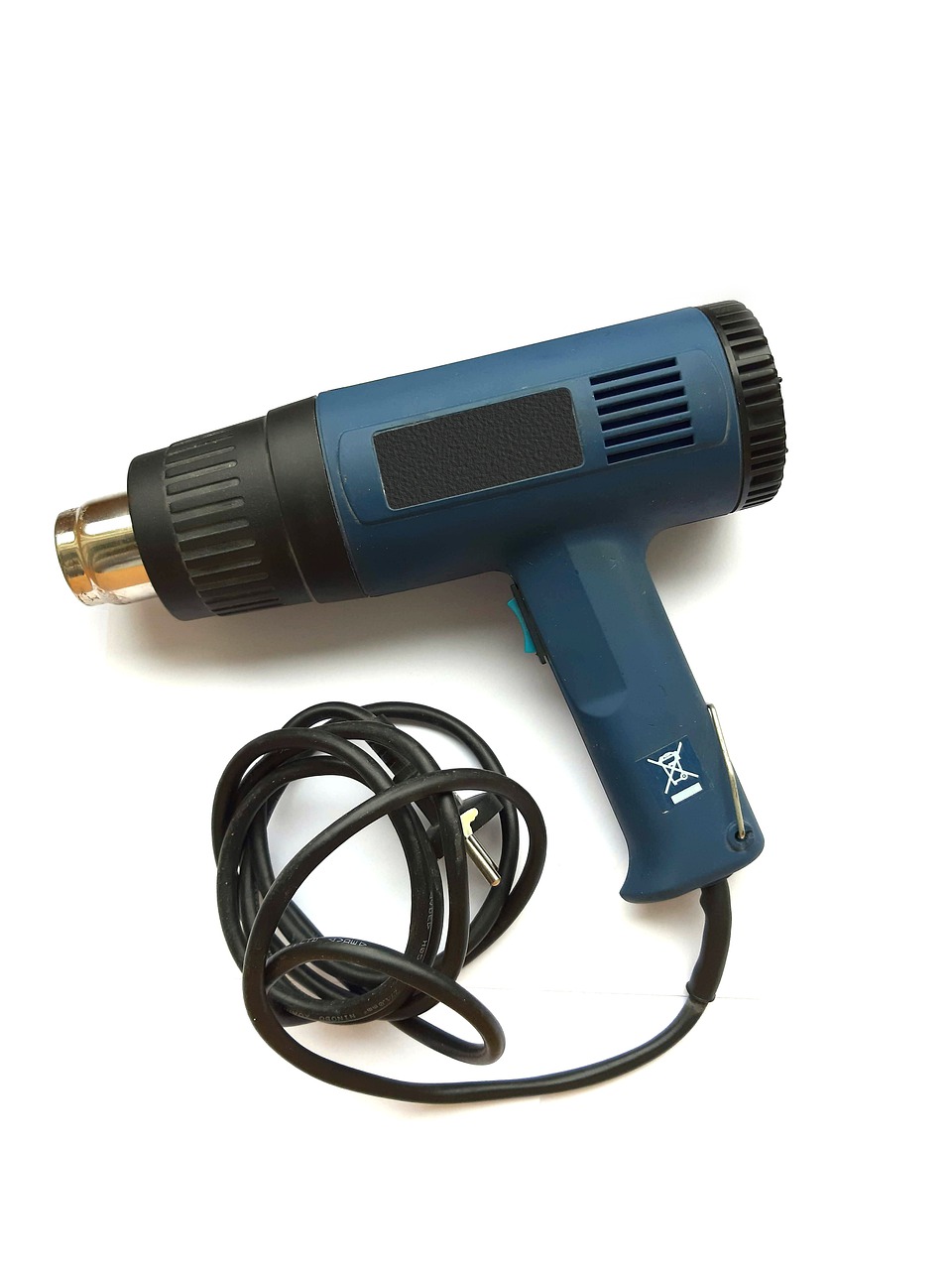
If a tool is handheld (not fixed in place), it’s classified as a portable power tool. It may operate either by battery or via an electrical cord. Following are the most popular portable power tools on the market.
Table of Contents
Belt Sander

- What it does: Removes wood stock quickly by driving an abrasive sanding belt over wood surfaces.
- What to buy: The 3″ × 21″ size is the most popular, and an 8- to 10-amp motor will handle most jobs. Buy a unit with a dust collection bag or a dust collection port that can be attached to a shop vac.
- Common accessories: Sanding belts in various grits.
Buffer/Polisher
View this post on Instagram
- What it does: Polishes wax finishes on wood and metal surfaces using a disc covered with a buffing pad.
- What to buy: Look for a unit with a 7″ backer pad and a lambswool bonnet. If you use this tool often, you’ll want 10 or more amps. If you’re an occasional user, you should buy one in the 5- to 7-amp range.
- Common accessories: Replacement bonnets.
Circular Saw

- What it does: This basic carpentry tool crosscuts and rips wood, plywood, and manufactured panels.
- What to buy: The 7 1/4″ model is the default. A 10-amp tool will do every typical job. Make sure the tool has a rip guide for making accurate rip cuts—if it doesn’t, buy one as an accessory.
- Common accessories: Replacement saw blades for cutting wood, plywood, and masonry.
Cordless Screwdriver

- What it does: This light-duty, rechargeable, battery-operated tool makes short work of driving flathead and Phillips-head screws.
- What to buy: A 3.6-volt, 180-rpm tool will handle most jobs. But for heavy-duty work, such as installing drywall panels, a full-sized corded (or cordless) tool is required.
- Common accessories: Various-sized screwdriver bits and hex-base, small-diameter drill bits.
Disc Sander

- What it does: This tool removes stock very rapidly from wood and metal surfaces, using discs with diameters between 4″ and 9″.
- What to buy: A 7″-diameter disc with a 6- to 10-amp motor will take care of most jobs. Make sure the tool comes with an auxiliary side-mounted handle.
- Common accessories: Replacement sanding discs in grits that range from coarse to fine.
3/8 ” Drill

- What it does: This default drill drives various bits to bore holes in wood and metal parts. It also accepts many different accessory tools for sanding, grinding, and shaping materials.
- What to buy: Choose a reversing tool with variable speed and an amp rating close to 6. A keyless chuck (no key needed to tighten or loosen a bit) is helpful.
- Common accessories: Drill, spade, and screwdriver bits; hole saws; flap sanders; and small grinding wheels.
Drill/Driver

- What it does: This cordless drill is equipped with an adjustable clutch that regulates the amount of torque that the tool delivers; this can be set to drive screws to a specified depth. Once this depth is achieved, the clutch disengages the drive motor.
- What to buy: A 14.4 volt, 3/8″ chuck, variable speed, reversing tool that comes with a charger and two batteries.
- Common accessories: Drill, spade, and screwdriver bits; hole saws; flap sanders; and small grinding wheels.
Electric Stapler

- What it does: Drives staples into wood for installing upholstery, screening, faced fiberglass insulation, and plastic vapor barriers.
- What to buy: A 7- to 10-amp rating, with a long cord (at least 6′) and a high/low switch to adjust the power to the material.
- Common accessories: 1/4″- to 9/16″-long staples.
Finishing Sander
View this post on Instagram
- What it does: Removes wood stock by driving a pad, covered with abrasive paper, in a tight orbital pattern. A finishing sander is much less aggressive than a belt or disc sander. It’s sometimes called a half-sheet sander because half of a standard abrasive sheet fits exactly on the tool’s pad.
- What to buy: A unit with ratings of 4–5 amps and 6,000 opm (orbits per minute).
- Common accessories: Standard sheets of abrasive paper in grits ranging from coarse to fine.
Glue Gun

- What it does: Melts glue sticks and applies the adhesive in a soft bead by squeezing the trigger. It quickly bonds wood, plastic, fabric, and paper.
- What to buy: Choose a tool with a dual heat range, a fold-down stand, and a watt rating from 50–100.
- Common accessories: Various types of glue sticks.
Hammer Drill

- What it does: A corded power drill, usually with a 1/2″ chuck, this unit is designed to drive a masonry bit in a back-and-forth, hammering motion while turning it in a rotary direction. This makes drilling holes in concrete and other masonry materials much easier.
- What to buy: A 7-amp, variable-speed model for use in masonry and wood. Look for a model with an on/off hammering switch.
- Common accessories: A variety of standard and masonry drill bits.
Heat Gun

- What it does: Much like a hair dryer, a heat gun draws in air from the room, sends it past a heating element, and blows it out a front nozzle. It’s used to soften paint and flooring adhesive so that they can be removed, as well as to melt frozen water inside plumbing pipes.
- What to buy: An 8- to 10-amp tool with an adjustable temperature control and a support stand.
- Common accessories: Nozzle heads in multiple shapes to direct the air flow into various patterns.
Jigsaw
View this post on Instagram
- What it does: With its narrow, up-and-down reciprocating blade, it can make circular and curved cuts in wood and thin metals, such as roof flashing and heating ductwork.
- What to buy: A variable-speed, 5-amp unit with an adjustable base and adjustable orbital cutting action.
- Common accessories: Various wood and metal cutting blades.
Laminate Trimmer

- What it does: This small router is designed to cut and trim plastic laminate during countertop construction.
- What to buy: A 4- or 5-amp tool with an rpm rating of about 25,000 and an adjustable base.
- Common accessories: 1/4″-shank router bits.
Palm Sander

- What it does: This finishing sander removes wood stock gently with a tight orbital action. It’s also called a quarter-sheet sander because a quarter sheet of standard sandpaper fits exactly on its base.
- What to buy: A unit with ratings of about 2 amps and 10,000 opm (orbits per minute).
- Common accessories: Abrasive paper in grits ranging from coarse to fine.
Plate Joiner
View this post on Instagram
- What it does: This tool is essentially a right-angle sander/grinder outfitted with a carbide circular-saw blade that cuts slots into mating boards. These slots are shaped to match small wood strips, called splines or plates, that are glued into the slots to hold two pieces of wood together.
- What to buy: A 5-amp tool with a pivoting fence that has stops at 0°, 45°, and 90°. It must cut slots to match all three common plate sizes: #0, #10, and #20.
- Common accessories: Joining plates.
Plunge Router
View this post on Instagram
- What it does: This tool cuts square or decorative edges on wood and manufactured panels like a standard router. It also makes plunge cuts in boards to hollow out voids for standard mortise-and-tenon joints.
- What to buy: Choose a 1 1/2–hp unit with 1/4″ collet (for 1/4″ bits), and a vacuum-hose attachment fitting.
- Common accessories: Various decorative and straight cutting bits.
Power Plane
View this post on Instagram
- What it does: A powered version of the standard hand plane, this tool has a rotating cutter that slices thin layers of stock from the edges or surfaces of wood boards.
- What to buy: A tool with a 3 1/4″-wide cutter, 4- to 5-amp motor, and 1/16″ depth of cut.
Power Shears
View this post on Instagram
- What it does: This tool cuts thin sheet metal, such as duct work and flashing, using three cutting blades: two stationary cutters on the sides and one that moves up and down between the other two.
- What to buy: A 5-amp, variable speed tool with a cutting head that rotates 360°.
Random-Orbit Sander
- What it does: This sander has a disc-shaped pad (covered with abrasive paper) that’s driven by the motor in a random orbit pattern. This removes stock faster than a finishing sander and doesn’t leave the pronounced circular scratches that disc sanders often leave behind.
- What to buy: A tool with a 5″-diameter disc, a 2-amp motor, a rating of about 12,000 opm (orbits per minute), and a dust collection bag.
- Common accessories: Replacement sanding discs in grits ranging from coarse to fine.
Reciprocating Saw
View this post on Instagram
- What it does: This long in-line saw drives its bayonet blade in a back-and-forth reciprocating direction. It’s used primarily for cutting through wood framing members during demolition work.
- What to buy: A variable-speed, 6-amp tool with a 1″ stroke length.
- Common accessories: Various metal and wood cutting blades.
Rotary Tool
- What it does: Often called by the leading brand name, Dremel, this small router cuts, grinds, drills, and polishes small parts.
- What to buy: A 1- to 2-amp, 5,000- to 25,000-rpm model with a 1/8″ collet (for 1/8″ shaft bits).
- Common accessories: Drill bits, grinding burrs, mini-router bits, felt pads, drum sanders, and more.
Router
- What it does: This tool’s motor drives a bit that extends below a fixed base to cut square or decorative edges onto wood boards and manufactured panels.
- What to buy: Choose a 1-1/2 hp, variable speed model with a 1/4″ collet (for 1/4″ bits).
- Common accessories: Various router bits that cut different decorative shapes and an edge guide for making consistent grooves along the length of a board or panel.
Soldering Gun
View this post on Instagram
- What it does: Melts solder for joining electronic components and fine-gauge copper wire.
- What to buy: A 200- to 400-watt, dual-temperature tool, with a top temperature of about 1,000°F and a built-in work light.

